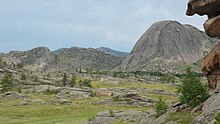
Granite domes are domical hills composed of granite with bare rock exposed over most of the surface. Generally, domical features such as these are known as bornhardts. Bornhardts can form in any type of plutonic rock but are typically composed of granite and granitic gneiss.[1] As granitic plutons cool kilometers below the Earth's surface, minerals in the rock crystallize under uniform confining pressure. Erosion brings the rock closer to Earth's surface and the pressure from above the rock decreases; as a result the rock fractures. These fractures are known as exfoliation joints, or sheet fractures, and form in onionlike patterns that are parallel to the land surface. These sheets of rock peel off the exposed surface and in certain conditions develop domical structures.[2] Additional theories on the origin of granite domes involve scarp-retreat and tectonic uplift.
- ^ Twidale, C. R. (2012-12-02). Granite Landforms. Elsevier. ISBN 9780444597649.
- ^ Bierman, Paul R. (2014). Key Concepts in Geomorphology. New York, NY: W.H. Freeman and Company Publishers. pp. 81–82. ISBN 978-1-4292-3860-1.
© MMXXIII Rich X Search. We shall prevail. All rights reserved. Rich X Search
